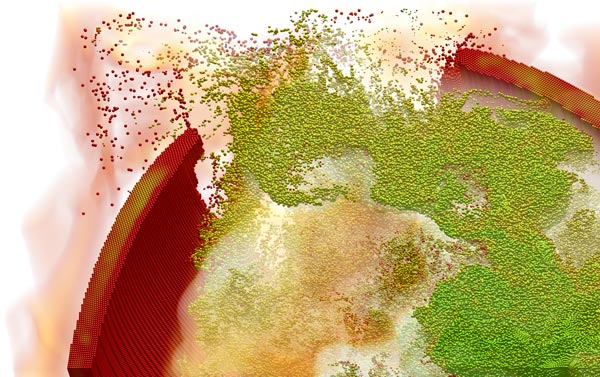
This Article From Issue
July-August 2007
Volume 95, Number 4
Page 350
DOI: 10.1511/2007.66.350
I met Chris Johnson in 2004 at a Workshop on Visualization Research Challenges sponsored by the National Institutes of Health and National Science Foundation. Chris is director of the Scientific Computing and Imaging (SCI) Institute at the University of Utah. The work at the institute is truly interdisciplinary. If you go to their Web site, http://www.sci.utah.edu, you'll see visualizations about electrical fields in the heart, three-dimensional segmentations of the brain and aircraft designs. A brief Sightings conversation with Chris and Assistant Professor of Computer Science Steven Parker, who led development of a tool for visualizing explosive fires, begins with my question to Chris.

Image courtesy of the University of Utah.
F. F. How did the idea for this visualization begin? Did the researchers come to you?
C. J. This visualization was developed for a project of the Center for the Simulation of Accidental Fires and Explosions (C-SAFE) one of five U.S. Department of Energy Advanced Simulation and Computing academic centers. C-SAFE is a multidisciplinary (computer science, chemical engineering, chemistry, mechanical engineering, materials science, mathematics) team of investigators who focus on providing state-of-the-art science-based tools for the numerical simulation of accidental fires and explosions, especially in the context of the handling and storage of highly flammable materials, that will help to better evaluate the risks and safety issues associated with fires and explosive devices. In order to realistically model the complexity of fires and explosions, C-SAFE uses computers at national laboratories to conduct large-scale simulations, generating terabytes of data that need to be visualized and compared with experiments.
Here at the SCI Institute, Steve Parker led an effort to create a new system to visualize very large data sets interactively and also to simulate lighting and shading effects (called global illumination) that are more realistic than traditional visualization techniques, in order to enhance scientists' and engineers' ability to better understand their simulation results.
S. P. I will just add that for this project, both the computation and visualization were performed by C-SAFE researchers through this collaboration. The simulation ran for almost a week on a large computer at Lawrence Livermore National Laboratory. C-SAFE is a highly interdisciplinary project where we have experts in several traditional academic disciplines working toward a common goal. This seldom happens in academic environments, but the results speak for themselves: We have a simulation that combines state-of-the-art fire models, structural models and explosive models, all in a state-of-the-art computational system and depicted with state-of-the-art visualization technology.
F. F. In the image here, what exactly do the color and size of the spheres represent?
S. P. Each particle, regardless of color, represents a small quantity of mass—about 1 cubic millimeter, or smaller, of steel or explosive. The colors of the particles indicate temperature, red being the hottest (temperatures at or above 450 kelvins) and green the coolest (just above room temperature), and moving through yellow and orange for temperatures between those extremes. The container was heated from the outside, so the steel is the hottest, and only the parts of the explosive that are actually burning get hot. They disappear rapidly as they burn.
In addition to the rainbow colors of the solid materials, you can see the engulfing fire displayed with a black-body color map that goes from black to orange to white as a function of temperature from room temperature to 2,100 kelvins (similar to what you would see in real fire).

American Scientist Comments and Discussion
To discuss our articles or comment on them, please share them and tag American Scientist on social media platforms. Here are links to our profiles on Twitter, Facebook, and LinkedIn.
If we re-share your post, we will moderate comments/discussion following our comments policy.